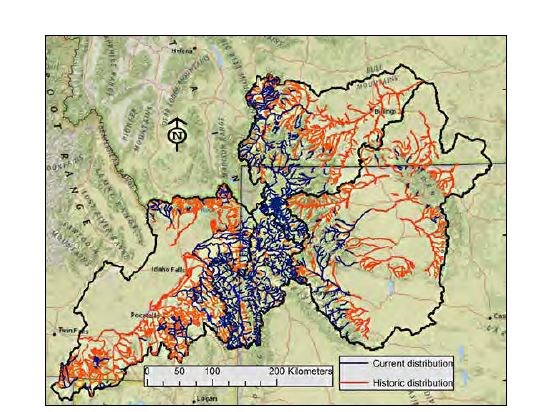|
from: Yellowstone Science 25 (1) by Dave Sweet, Wyoming Trout Unlimited
Native coldwater species, such as Yellowstone cutthroat trout, westslope cutthroat trout, fluvial Arctic grayling, and mountain whitefish, are especially important to the natural ecology and human enjoyment of the Greater Yellowstone Ecosystem (GYE). In the early 2000s, these native coldwater species faced multiple threats; the most significant were from introduced non-native aquatic species, including lake trout, brook trout, rainbow trout, and the exotic parasite that causes whirling disease. Of particular concern was the rapid decline of Yellowstone cutthroat trout in Yellowstone Lake and the upper Yellowstone River system due to introduced lake trout. Yellowstone National Park (YNP) managers recognized these threats and implemented a plan of action to address them as described in the Native Fish Conservation Plan (Koel et al. 2010). A missing link, however, was a process to better incorporate anglers, conservation groups, and the general public with on-the-ground actions to conserve native fish as described in the plan.
In late 2011 and early 2012, a consortium of conservation groups met with YNP officials with the intent of becoming a partner in addressing the threats to the Yellowstone Lake fishery and the lake ecosystem. From that meeting and subsequent discussions, a Memorandum of Understanding (MOU) was developed that formalized a cooperative relationship among participants to ensure the GYE is protected, maintained, and managed to achieve established goals. The groups which were signatures to the MOU are Trout Unlimited National, Wyoming Council, Montana Council, and Idaho Council; National Parks Conservation Association; Greater Yellowstone Coalition; Yellowstone Park Foundation; and Yellowstone National Park. Some of the goals of the MOU and its partners include:
The Yellowstone Lake Working Group acts as a sounding board to review lake trout suppression activities, population monitoring activities and trends, telemetry research results, new suppression technologies, and other fisheries-related science. They also initiate positive public outreach and education, and have authored publications directed at the general public and potential funders, including a publication with answers to frequently asked questions about the science supporting management of Yellowstone Lake (Trout Unlimited 2014). The group responds to public concerns about fish conservation actions when applicable. The Yellowstone Lake Working Group is actively involved in fundraising and has raised over one million dollars to directly support Yellowstone cutthroat trout restoration in Yellowstone Lake. The majority of the funds are spent on telemetry studies on the seasonal movement patterns of lake trout and the location of lake trout spawning areas; on studies assessing the reproductive potential, cycles, and timing of lake trout spawning; and on studies which identify and optimize alternative suppression technologies aimed at lake trout ova and fry. The Yellowstone Lake Working Group contracts with U.S. Geological Survey scientists and fisheries professionals at multiple universities to complete the research. In addition, partners of the Yellowstone Lake Working Group provide volunteer labor to support the work on Yellowstone Lake. Over the past five years, the Yellowstone Lake Working Group has proven to be an incredibly valuable partnership. Working together, the team has made significant advancements towards restoration and the long-term preservation of native cutthroat trout and the natural ecology of Yellowstone Lake. Literature CitedKoel, T.M., J.L. Arnold, P.E. Bigelow, and M.E. Ruhl. 2010. Native fish conservation plan. Environmental assessment, December 16, 2010. National Park Service, U.S. Department of the Interior, Yellowstone National Park, Wyoming, USA. Trout Unlimited. 2014.Science supporting management of Yellowstone Lake fisheries: responses to frequently asked questions. Trout Unlimited, Lander, Wyoming, USA. http://wyomingtu. org/wp-content/uploads/2014/03/Science-Supporting- Management-of-Yellowstone-Lake-Fisheries.pdf Dave Sweet is a trained chemist who happens to love fly fishing and our native trout species. Here in the west that means cutthroat trout. In particular, he has been working on the restoration of Yellowstone cutthroat trout in Yellowstone Lake for the past 8 years. These fish and the ecosystem that they support have been devastated by invasive lake trout, their numbers reduced to 5-10% of historic levels. Dave is an avid member of Trout Unlimited, serving currently as Wyoming Trout Unlimited Treasurer and Yellowstone Lake Special Project Manager. The work on Yellowstone Lake has earned Dave TU’s Distinguished Service Award, Field and Stream magazine’s 2013 Hero of Conservation Award, and induction into Wyoming’s Outdoor Hall of Fame in 2014. He lives in Cody, Wyoming, with his wife Cathy and has two daughters, Cindy and Diana and one grandson, Spencer. He is currently retired. 
|
Last updated: February 21, 2017
